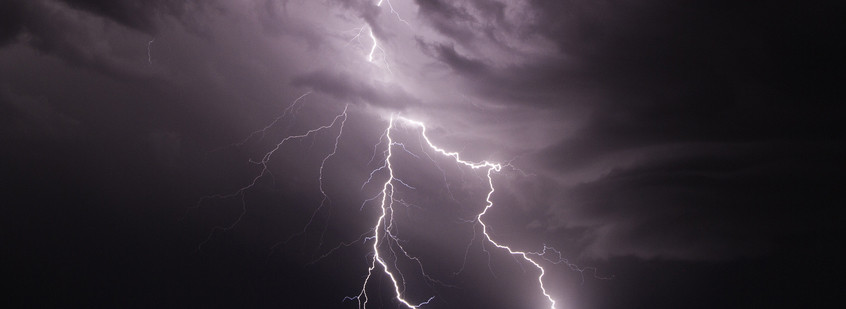In Australia, there are between five and 10 deaths from lightning strike annually, as well as over 100 injuries.
In fact, a study from 1996 reports that from 1803 to 1992, 650 people have died in Australia from lightning strike in total.
The majority of fatal lightning strikes were found to have occurred in late spring/summer, and between noon and 6pm. Of the victims, 7.4 per cent were in tents. A sobering thought for bushwalkers, since all tent poles, whether aluminium or carbon fibre, make for excellent conductors of electricity.
While you can never predict exactly where lightning will strike, there are several areas of the country that show a higher propensity towards receiving a higher frequency of electrical storms, with these lightning hotspots being found in the far north closest to the equatorial zone.

This image of a lightning strike in Namadgi National Park, ACT was captured by Wild reader Judith Deland.
Lightning is a form of electrical discharge between clouds (‘cloud-to-cloud’ lightning) or between a cloud and the ground (‘cloud-to-ground’ lightning) and in general, occurs when warm and cold air mix. Lightning is typically (but not exclusively) associated with thunderstorms which occur when there is moisture in the atmosphere (sometimes indicated by low clouds or haziness in the morning and/or many cumulus clouds later), atmospheric instability, and hot air or the approach of a front or low pressure trough (for more information, see the Bureau of Meteorology’s handbook on thunderstorms).
Survivors of lightning strikes report that prior to being struck their hair was standing on end and they had a metallic taste in their mouth. Long-term injuries from a lightning strike can include memory and attention loss, chronic numbness, muscle spasms and stiffness, depression, hearing loss and disrupted sleeping patterns.
Lightning strike is a major cause of bushfires, the incidence of which has increased over time. In Tasmania, lightning-ignited fires have been previously recorded as being uncommon, mainly due to the high incidence of rain following storm activity. However, lightning is now regarded as the major cause of wildfire in the Tasmanian World Heritage area.
In Victoria, the 2003 (and probably 2006) alpine fires started after lightning strike. The average chance of a fire starting per lightning stroke in Victoria is 0.42 per cent, and this is dependent on elevation, spatial distribution of lightning, vegetation composition and fire weather conditions. The chance of a fire being ignited from a lightning strike was found to be greatest during January.
Lightning-ignited fires often start in inaccessible terrain, which present challenges for their control. Rocky and mountainous terrain, combined with the high wind speeds typically associated with storm activity, can also lead to quickly spreading fires with unpredictable behaviour.
So what can bushwalkers do to prevent being hit by lightning? Obviously observations of the immediate and current weather conditions are important. But sometimes lightening can strike unexpectedly. Chances of being struck can be reduced by: avoiding high ground, water, solitary trees, open spaces, and metallic objects.
Search for low ground, but avoid ditches or trenches if they contain water, or if the ground is saturated. Seek clumps of shrubs or trees of uniform height. Immediately remove all metal objects from your person and vicinity. Get into a low, crouching stance on the balls of your feet, with minimal contact with the ground, with your hands covering your ears. Stand spread out from others, around six metres between each person. Avoid metal rain and sun shelters, and where possible remove metal items such as glasses or watches and place these well away from you.
There are also pocket devices that can aid in detecting lightning up to 65 kilometres away, and these may well be worth using, especially if you’re heading into a lightning hotspot during the busiest time of year for electrical storms. After all, you can never be too careful. An ecologist I know has been struck twice while working in the Victorian Alps!



